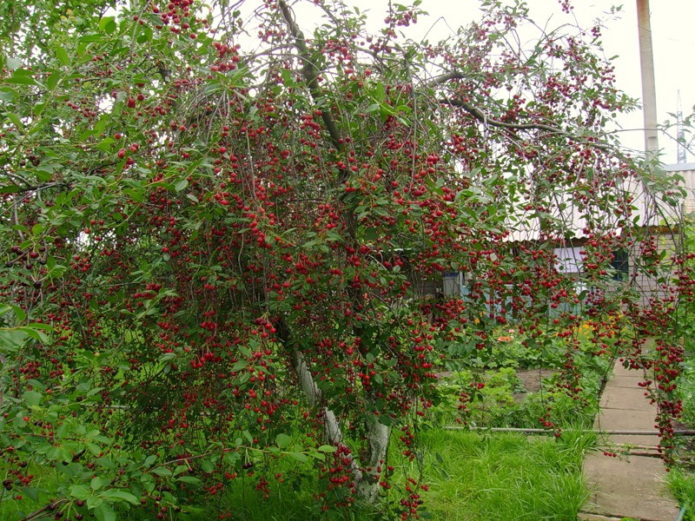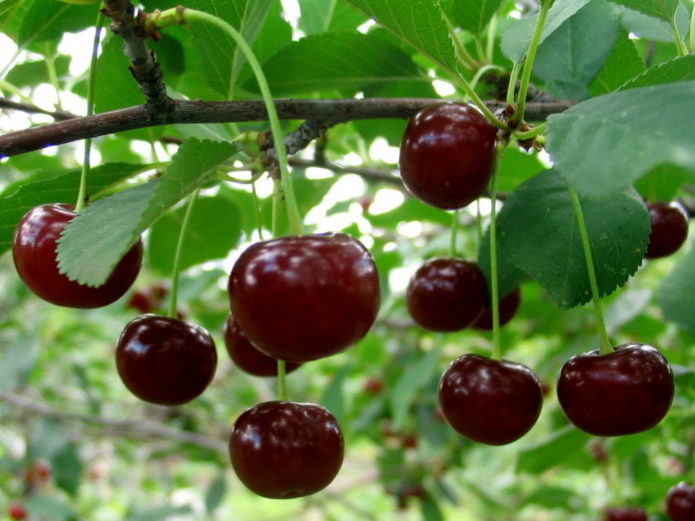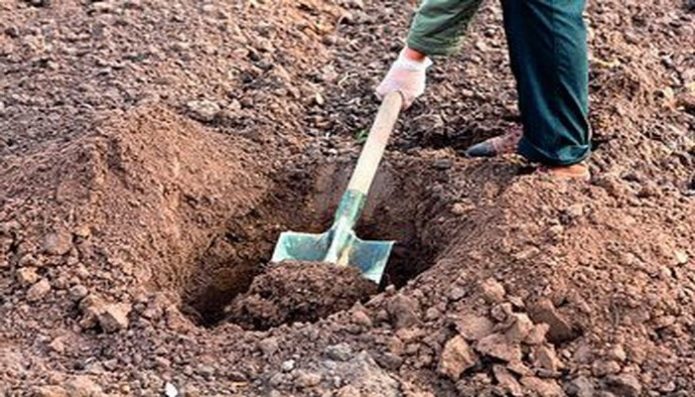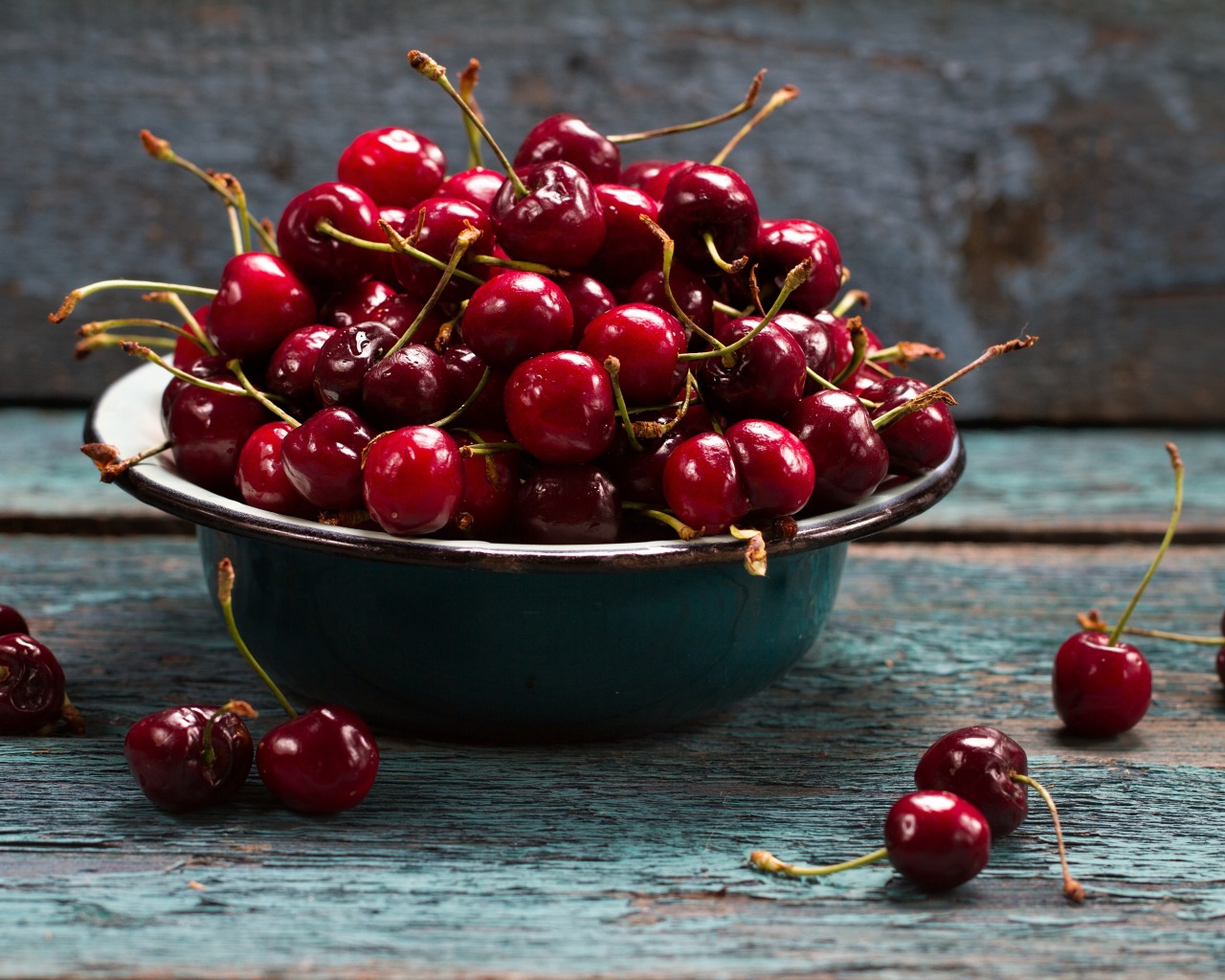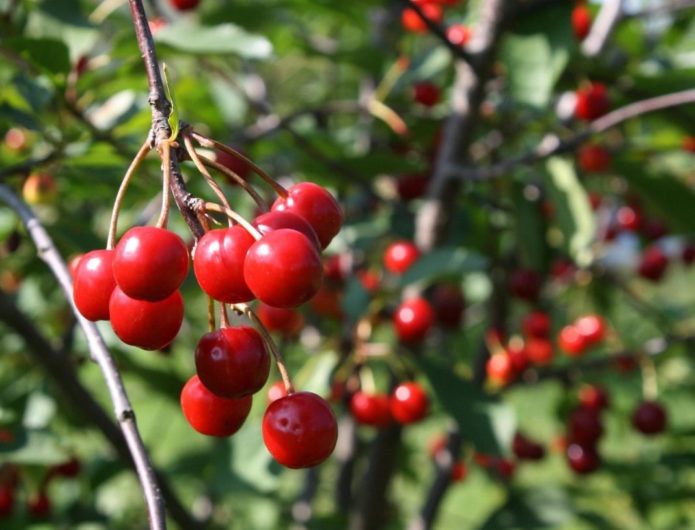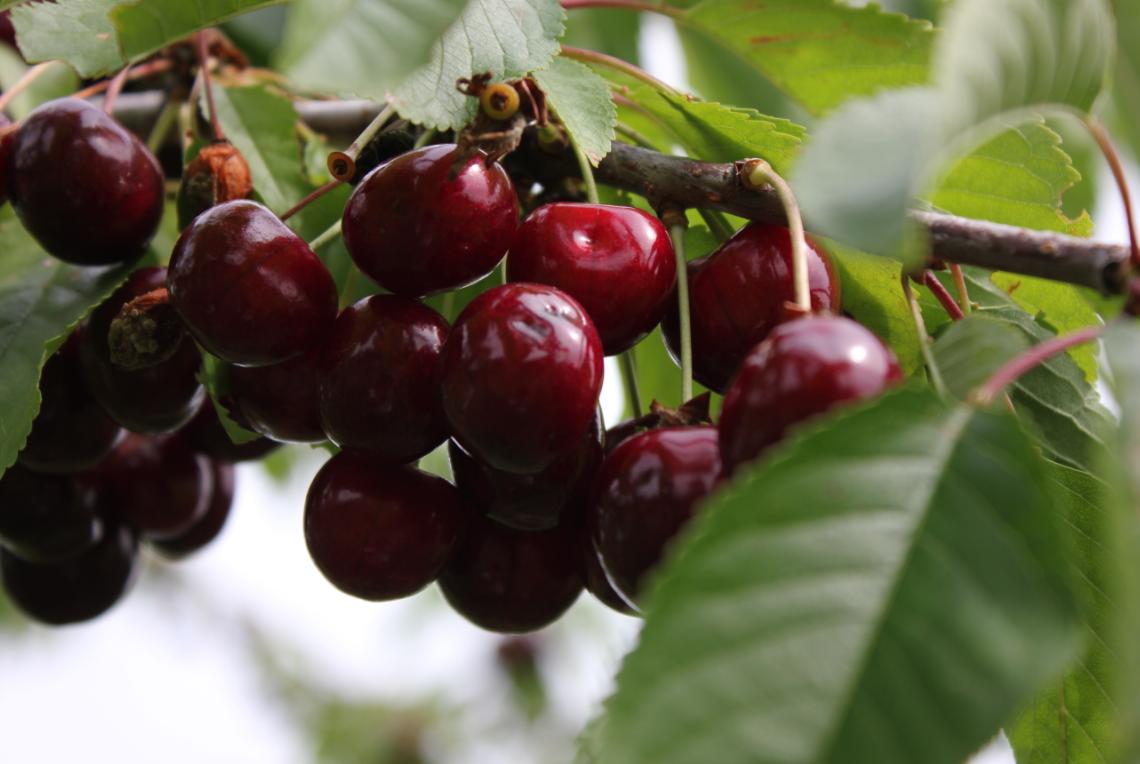Fresh and ripe cherries are one of the favorite delicacies of both children and adults, so every owner of a garden plot strives to grow their own cherry tree. Of course, special attention is paid to the choice of the variety: the tree should not be too whimsical to care for, but at the same time fruitful, and its fruits should be sweet and juicy. One of these varieties is a cherry called Vstrecha.
Content
Meeting History
The homeland of the variety is Ukraine - Cherry Vstrecha appeared in 1966 in Melitopol (to be more precise, at the MF Sidorenko Institute of Irrigated Horticulture of the NAAS). The breeding was carried out by Nikolai Ivanovich and Valentina Alekseevna Turovtsevs, who were later assigned the authorship of the variety. The “parents” of the Meeting were cherries of national selection called Lyubskaya and Duke (that is, a hybrid of cherry with cherry) Kievskaya-19.
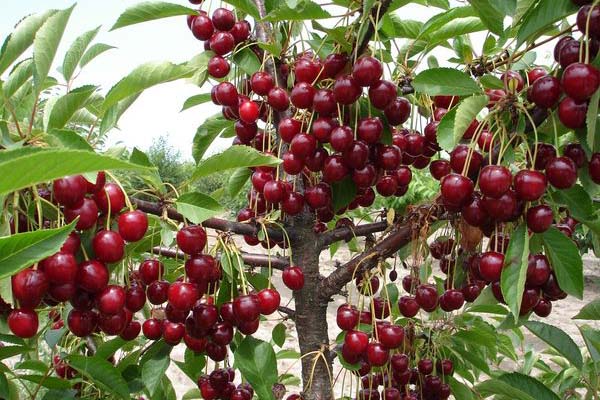
A valuable and large-fruited variety Vstrecha appeared as a result of crossing Lyubskaya cherry with Kievskaya-19 duke
In 1995, the meeting was entered into the State Register of Plant Varieties of Ukraine under the identifier 82074001 as a universal medium-late variety, and zoned for the steppe zone.
Description of the variety
The tree is bushy, weakly growing, even dwarf (maximum height - 2 meters). The crown is dense, spherical, drooping. The leaves are large, oval, with jagged edges, green. Cherry begins to bear fruit in the third or fourth year after planting, the fruits are formed on annual growths and bouquet branches. Fruit weight can vary from 8.6 to 15 grams, the average cherry weighs 9 grams.
Cherry pits are loose, medium-sized, rounded, slightly compressed on the sides, and are separated from the pulp without any difficulty. The skin is dark red, shiny, thin, but at the same time dense, easily separated from the fruit. The pulp is red, juicy and tender, the juice is raspberry. The cherry taste is excellent - from 4.75 to 5 points on a five-point scale. The fruits are universal - they can be used both for fresh consumption and for winter preparations, preparation of various dishes and freezing. Cherries of this variety tolerate transportation over long distances quite calmly, therefore, they are also suitable for growing for commercial purposes.
Cherry does not tolerate being close to apricot, pear, plum, walnut, currant and peach. Ideal neighbors for her are cherries and grapes.
The meeting is recommended for cultivation in the eastern, southeastern and southern parts of Ukraine, although it is also found in other regions of the country. They love her in Russia too. Officially, the variety is considered to be mid-late - ripening of the fruits begins in the 20th of June. The yield of cherries of the Vstrechaya variety is quite high: with good care, one adult tree can produce 25–28 kg of fruit. At the same time, cherry is highly frost-resistant, tolerates drought well and is rarely affected by such dangerous diseases as coccomycosis and moniliosis.
Variety Vstrecha is partially self-fertile (some sources claim that it is completely self-fertile), therefore, for normal fruiting, it requires the presence of third-party pollinators on the site. The best pollinators for this cherry are considered to be Shalunya, Lyubskaya, Samsonovka, Primetnaya and Valery Chkalov.
The subtleties of planting cherries
Any cherry, including Vstrecha, prefers to grow in neutral and light sandy loam or loamy soil. For planting, you should choose well-lit, drained areas, protected from gusts of cold wind and located at a low elevation. Moreover, the Meeting can grow in the shadows.
The soil in the area where the tree is planted must be loose, water and breathable. In heavy clay or too acidic soils, as well as where groundwater is close to the surface of the earth, cherries will not grow.
A simple test can help you figure out if the soil on your plot is suitable for growing cherries. Take 3-4 blackcurrant leaves and pour a glass of boiling water over them. When the substance has completely cooled down, stir it slightly with a spoon and dip a lump of earth into a glass (only you need to take it not from the surface, but from a hole about 35 cm deep). The bright red color of the solution indicates a strongly acidic soil, pink - about medium acid, and blue - about alkaline. If the liquid turns green, the soil on the site has a neutral reaction, which means that the cherry will like it.
If you find out that the soil on the site has an acidic reaction, it will need to be limed before planting cherries. In acidic sandy loam soils, they add 0.5 kg of lime per square meter, and in loamy soils - 700 grams. Lime is distributed over the site, after which it is dug up to a depth of about 30 cm. If you plan to plant a tree in the spring, the liming procedure must be carried out in the fall, and vice versa.
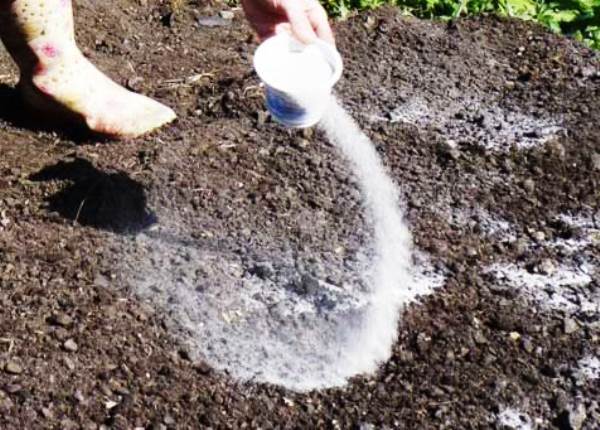
Liming must be carried out so that the rhizomes of plants become powerful and better absorb nutrients
Cherry seedlings are best purchased in specialized nurseries - this greatly reduces the risk of getting a re-grading instead of a real meeting... The age of plants should not exceed two years - older trees almost certainly will not be able to take root in a new place and will die. The root system of seedlings should be strong and well developed, there should be no cracks on the bark, and signs of disease on the leaves.
Before planting a young tree in the soil, immerse its roots in Kornevin's solution for 6–8 hours - this will help the plant to take root more easily and provide it with protection from fungal diseases during the rooting stage. Instructions for using the drug are indicated on the package.
Planting time depends a lot on climatic conditions. In the southern regions it will be better to carry out planting work in the fall, and in the northern regions - in the spring.
If planting is done in the spring, then trees are planted after the last snow melts and the soil dries out a little. According to the observations of experienced gardeners, cherries planted in mid-April take root best.
The disembarkation procedure is carried out according to the following scheme:
- A month (or at least 2 weeks before planting) a hole is dug on the site 50–60 cm deep and 68–80 cm in diameter. If you plan to plant several plants, the distance between them should be at least 3-4 meters (although the Vstrechaya variety is undersized, but its crown is spreading, therefore, when planting closer, the grown trees will interfere with each other). At least 3 meters must be retreated from tall trees, fences and buildings.
- The soil taken out of the pit is mixed with mineral fertilizers - superphosphate (40 grams), potassium sulfate (25 grams) and wood ash. Nitrogen fertilizers and lime cannot be added to the nutrient mixture - they will burn the delicate roots of young cherries.
- Immediately before planting, a peg is driven into the center of the hole, which will serve as a support for the plant until it is completely rooted.
- A layer of nutrient mixture is poured around the peg, and a seedling is placed on top, carefully straightening its roots. Make sure that the tree trunk is on the north side of the peg, and the root collar remains at ground level or rises 3 cm above it - cherries do not tolerate buried planting.
- Sprinkle soil over the roots of the seedling, tamp it down carefully. After stepping back 30–40 cm from the trunk, surround the cherry with an earthen roller so that when watering, the water does not spread beyond the hole.
- Tie the tree to a support, pour it with two buckets of water and mulch the soil in the trunk circle with humus, grass cuttings, peat, straw, sawdust or other similar material.
Over the next three to five days, the seedling needs increased watering, but do not allow excessive waterlogging - otherwise, the roots of the plant will simply rot.
Cherry care features Meeting
In order for a cherry of the Vstrechaya variety to please you with large berries from year to year, you need to take care of it. The variety does not have any individual requirements, therefore, it is cared for according to general agricultural technology:
- Cherry is watered at least three times per season - during periods of growth of young shoots, flowering and ripening of fruits, bringing at least three buckets of water under the tree. Focus on what the weather is like - in extreme heat, plants are watered more often, and in very rainy summer watering may not be necessary at all.
- In a cold and rainy spring, trees are sprayed with a solution of honey (100 grams per 10 liters of water) to attract pollinating insects to them.
- They begin to fertilize the plant from the third year of life. In the spring, before budding, 20 g of ammonium nitrate, 10 g of double superphosphate and 5 g of potassium salt are added under the trees for each square meter of the trunk circle (to find out the diameter of the trunk circle, measure the crown of the fruit tree and multiply this indicator by 1.5) ... When the cherries bloom, they are fed with wood ash (a liter can of 10 liters of water under each tree) and a solution of 2 tbsp. l potassium sulfate and 1 tbsp. l of urea (also for 10 liters of water). During the period of fruit growth, the trees are again fertilized with ash, and after the autumn leaf fall, 1-2 buckets of humus are added under each tree.
- In the spring, the crown is pruned, removing weak, diseased, dried and thickening branches. Be sure to remove the root growth.
- Once every 3-4 years, the soil in the area where the cherry grows is lime - this procedure not only normalizes the acidity of the soil, but also helps the root system to better absorb nutrients. Cherries also need lime to form pits.
- Two - three times a season, loosen the soil in the tree trunk circle, and in the fall - shallow digging.
- To prevent cherries from suffering from diseases, do not neglect preventive measures. In the spring, whitewash the stem and some of the lower branches with a special tool (you can buy it at any garden store). At the beginning of the growing season, spray the tree with a 3% Bordeaux liquid, copper sulfate (100 grams per 10 liters of water) or a fungicide (for example, Horus). Preventive spraying with fungicidal preparations is carried out immediately after the flowers wilted, and then repeated after another 10 days. Be sure to remove from under trees and burn fallen leaves and fruit debris. Lubricate deep wounds on the bark with garden varnish to avoid infection. If the prophylaxis did not work, and you notice signs of a disease on the cherry, treat it with the appropriate insecticidal or fungicidal agents.
- If the summer turned out to be dry, in the fall, carry out a moisture-charging watering, adding at least 10 buckets of water under each tree. In rainy years, there is no need for such an event.
Video: how to properly prune a cherry tree
Reviews about the cherry variety Vstrecha
I have a cherry The meeting has been growing for the fourth year. My all really like it. I bought it in Agrus. Height 2 meters. A round bush with large leaves, very large and very tasty berries.The berries taste more like cherries, and they look like cherries.
Yes, I also have the "Vladimirskaya" variety and I like it, but the "Vstrecha" variety is sweeter, the yield is high and the fruits are larger. During fruiting, my daughters do not deviate from this particular variety.
I am satisfied with the meeting. Ripening period is average. Partially self-fertile. Resistant to moniliosis and coccomycosis. Drought-resistant and winter-hardy. The fruits are large, flat-round.
Cherry Meeting is not too demanding in care, rarely gets sick and gives excellent yields, and due to its compact size and aesthetic appearance of the crown, it can serve as a real decoration of the site. Observing the simple rules of agricultural technology, you will annually receive returns from the plant in the form of delicious large fruits.
